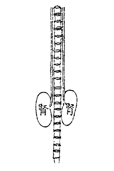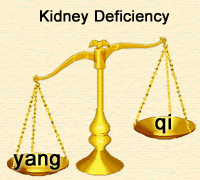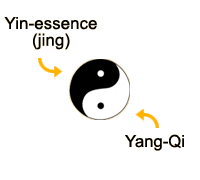Understanding Kidney Yin and Kidney Yang
 |
| The yin-yang Symbol |
The theory of yin-yang is a conceptual framework used for observing and analyzing the material world in ancient China. The theory permeates all aspects of traditional Chinese medicine. It serves to explain the organic structure, physiological functions and pathological changes of the human body, and in addition guides clinical diagnosis and treatment and prevention.
When The theory of yin and yang is used to explain the organic structure of the human body; the physical form pertains to yin, while activities or functions pertain to yang. The physical forms are the material basis for functions, while functions are the motivating power for physical forms. They are mutually complementary. TCM views the kidneys as the center of the body's yin and yang, the "congenital foundation," or the origin of life. In other words, the kidneys store the primordial yin and primordial yang (also called kidney yin and yang), which is the place where nutrients are stored and physiological functions take place.
Kidney yin, also called primordial yin, true yin or true water, is the foundation of the yin fluid of the whole body; it moistens and nourishes the organs and tissues.
 |
| TCM kidneys |
Kidney yang, also called primordial yang, true yang or true fire, is the foundation of the yang qi of the whole body; it warms and promotes the functions of the organs and tissues.
Kidney yin provides energy for physiological functions while kidney yang promotes storage of kidney yin. Kidney yin and yang are mutually dependent, promoting and restraining each other, leading to an internal harmony of yin and yang, and healthy functioning of the body's organs. It is the dynamic interaction between the two that maintains the normal life activities. The third chapter of Suwen (The Book of Plain Questions) confirms this by saying, "When yin is stabilized and yang well-conserved, the spirit will be in harmony; separation of yin and yang will cause exhaustion of essence and qi." This statement implies the mutual relationship of yin and yang.
When imbalance Occurs
When the balance of kidney yin and kidney yang is disrupted, pathological changes take place and illness occurs.
Presentations of kidney yin deficiency include: soreness and weakness of the lumbar regions and knees, dizziness, ringing in the ears, hearing problems, a dry mouth and throat, a hot sensation in the palms, soles and chest, spontaneous sweating, constipation, and seminal emission. The pulse is weak or fine and rapid; the tongue is red and covered with a light coating of fur. Kidney yin deficiency syndrome always produces signs of yin vacuity internal heat.
Presentations of kidney yang deficiency include: soreness or cold sensation in the knees and lumbar regions, aversion to cold, cold limbs, spiritual fatigue, difficulty in urination, enuresis, incontinence, declining libido, or impotence in severe cases; female sterility, and general edema may also appear. The pulse is fine or fine and deep; the tongue is bulky, moist, and covered with white fur. Kidney yang deficiency syndrome always produces signs of yang vacuity internal cold.
 |
| Kidney deficiency usually presents as lumbar soreness |
Kidney yin and kidney yang always influence each other, since they are mutually dependent. Therefore if kidney yin suffers long-term damage, kidney yang will be affected and result in depletion of both yin and yang. This is called "impairment of yin affecting yang" and vice versa.
This is why in routine TCM therapies, tonifying yin will also support yang and tonifying yang will also support yin, or tonify both yin and yang at the same time, by this means the state of equilibrium are restored. According to the clinical diagnosis, yang and yin are invigorated to different degrees. In the Ming dynasty (1368-1644), a notable physician, Zhang Jiebin (1563-1640) had the celebrated idea that "The body is prone to deficiency rather than excess. It is necessary to warm and tonify kidney yin and kidney yang from time to time, and to use cold-cool and potent drugs with caution. Therefore the kidney, which is the root of all the organs, can be consolidated." He also claimed that "when tonifying the yin, yang should be protected, not suppressed, and vice versa." This concept is generally accepted today, and many of his formulas relating to kidney tonification are still popular.
In respect to deficiency in kidney qi and kidney yang
 |
| Kidney yang deficiency and kidney qi deficiency represent different stages of a process. |
Kidney yang deficiency and kidney qi deficiency have similar presentations; however they can still be differentiated clinically. Manifestation of kidney yang deficiency follows the rules of yang vacuity internal cold; therefore it usually presents cold symptoms, e.g. cold and pain in the lumbar area and cold limbs. Kidney qi deficiency is a common clinical diagnosis and does not usually present with cold symptoms. When the kidney's astringent or storage functions are poor with a kidney qi deficiency, associated symptoms appear, e.g. frequent urination, copious amounts of clear urine, incontinence, enuresis, seminal emission, abortion, or miscarriage.
Kidney yang deficiency and kidney qi deficiency represent different stages of a process; improper management of kidney qi deficiency leads to kidney yang deficiency; in contrast, proper management of kidney yang deficiency leads to less severe symptoms of a kidney qi deficiency and then gradual recovery to the normal state.
In respect to kidney qi and kidney essence
 |
| Essence and qi come under different categories. |
In ancient times, qi belonged to yang and was called yang-qi. Therefore, kidney qi belongs to yang, and represents all the functions of the kidney. On the other hand, the body's essence, blood, and fluid are generally called yin essence in TCM. Yin essence is material basis for the body's physiological functions as well as the kidneys as a whole. Manifestation of kidney yin deficiency follows the rules of yin vacuity internal heat; therefore it usually presents heat symptoms, e.g. a dry mouth and throat, a hot sensation in the palms, soles and chest. However deficiency in kidney essence does not usually present with the heat symptoms.
Simply speaking, citing the analogy of yin and yang, kidney essence is the material basis, kidney qi is the functional force. Kidney essence and kidney qi are complementary and closely associated.
Conclusion
 |
| During TCM consultation, the yin-yang theory is superordinated to other theories. |
Imbalance of kidney yin and kidney yang leads to many diseases, and affects all organs of the body. For accurate diagnosis of a condition, it must be first ascertained whether there is a deficiency of yin or yang, before identifying the organs involved. For example in chronic nephritis, chronic renal failure, or senile kidney deficiency diseases, the usual TCM syndromes are kidney qi deficiency, kidney yang deficiency, qi deficiency in the kidney and spleen, yang deficiency in the kidney and spleen, kidney yin deficiency, yin deficiency in kidney and lung, yin deficiency in kidney and liver. Careful diagnosis can increase the effectives of treatment.
Written By:
Prof. Zou Yanquan (¹Q¿P¶Ô±Ð±Â)
Affiliated Hospital of Nanjing TCM University
National Medical Center of TCM Kidney Disease
Editors:
Angela Collingwood MSN, Integrated Chinese Medicine Holdings Ltd.
Jennifer Eagleton, BA & MA (Asian Studies), Integrated Chinese Medicine Holdings Ltd.
Rose Tse, Integrated Chinese Medicine Holdings Ltd.
|